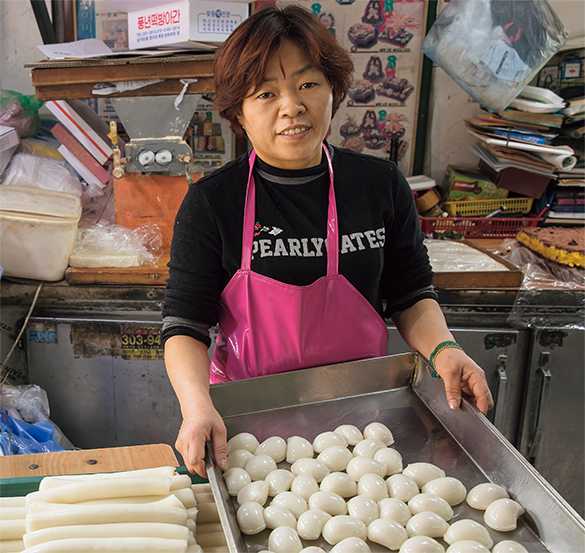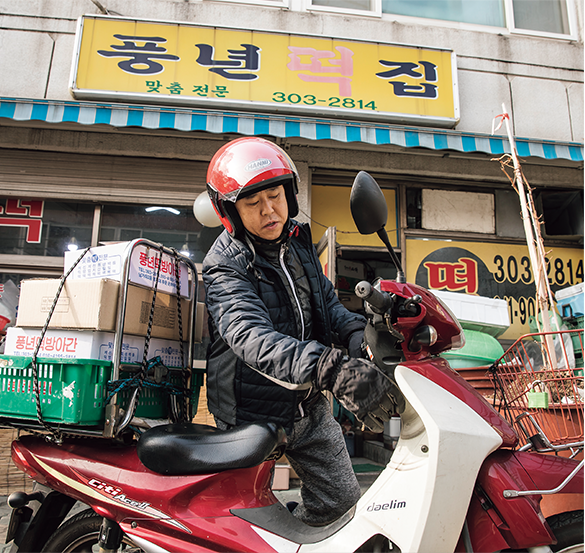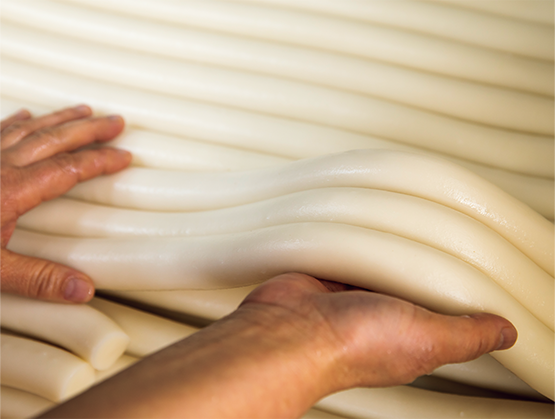It will still be another hour or two until dawn, but the ddeok shop is already busy with the lights inside shining brightly. This demand of the job means that anyone who wants to run a shop like this must be very hard-working by nature. I met a husband and wife who have been operating a small rice cake shop in an unassuming neighborhood of Seoul for the last 20 years and traced their daily routine, which begins while the city sleeps.
At Pungnyeon Ddeok Shop, in the modest neighborhood of Namgajwa-dong in Seoul, owner Kim Jae-eun wraps small portions of different rice cakes onto Styrofoam trays for her shop’s window display.
Kim Jae-eun’s life can be divided into before and after she started making ddeok, those chewy confections usually made of rice and commonly known as rice cakes in English. Before, she worked tirelessly and was unhappy but now, working just as hard, she is happy. Not only has ddeok allowed Jae-eun to live in economic comfort, she is also grateful for her life of making rice cakes because it has opened her heart toward her husband.
Pungnyeon (“Bumper Year”) Ddeok Shop, which Jae-eun runs with her husband, Oh Se-yeong, is a five-minute walk from the back gate of Myongji University in Namgajwa-dong, one of Seoul’s older neighborhoods. Here, in their 10-pyeong shop (one pyeong equals approximately 3.3 square meters), Jae-eun and Se-yeong are busy all day every day, making a whole array of rice cakes in different shapes and colors.
“What time do we start work? Well, 2 a.m., 3 a.m., 4 a.m; it really depends,” said Jae-eun, pausing to describe their business. “The time we start for the day changes according to what orders we have. But no matter what time we start, we finish around seven in the evening. Rice cake shops in locations with lots of foot traffic, like near subway stations or in the city center, sometimes stay open as late as 10 p.m., but we’re in a residential area, so as soon as it gets dark, customers stop coming by.”
Laborious Daily Routine

Stuffed rice cake pockets, called baramddeok, loosely pressed into half-moon shapes with a white or red bean paste filling, are particularly popular with younger customers because of their sweet taste.
No preservatives are added to rice cakes so they have to be delivered quickly, as soon as they are made. This means that when there are deliveries to be made early in the morning, Jae-eun and Se-yeong start work long before dawn.
Jae-eun has a notepad filled with details on different orders, including the date and time of delivery. Work on some recipes has to be started the day before delivery, so orders for the next day must be checked and preparations completed accordingly before going home. Rice needs to be washed and allowed to soak overnight, and sweet red bean paste and white bean filling may have to be made.
When Jae-eun and Se-yeong arrive at their shop, the first thing they do is switch on the boiler of their steamers. Then they drain the rice that was left to soak overnight and feed it into one of three milling machines. Once the rice is pounded into meal, it is ground into a fine powder, then loaded into stainless steel trays, which are placed in a large steamer.
There are slight variations depending on the kind of cakes being made, but in most cases it takes about 10 to 15 minutes until the delicious cakes are ready. The kinds of rice cakes Jae-eun and Se-yeong make are too many to be listed here.
They include garaeddeok, cylinder-shaped plain rice cakes; siruddeok, steamed rice cakes ed with red beans; injeolmi, sticky rice cakes coated with roasted bean powder; yaksik, honeyed rice with nuts; green songpyeon, half-moon-shaped rice cakes colored with ramie leaves and stuffed with peeled kidney beans; and baramddeok, half-moon-shaped, stuffed rice cake pockets. Pungnyeon Ddeok Shop is particularly famous for siruddeok made with glutinous rice. Sixteen kilos of red beans are boiled every single day just to produce that cake alone.
Se-yeong makes deliveries on his moped and a few types of cakes are placed on small Styrofoam trays, packaged with clear plastic wrap and put on display in the front window to attract customers.
The Main Customers
“This goes for all foods really, but the secret to making the best tasting rice cakes is to use good ingredients,” Jae-eun said. “My older sister sends us things like rice and beans that she has grown herself in our hometown Iksan, in North Jeolla Province. Our customers have quite discerning palates. If we were to use ingredients of lower quality, they’d notice it right away.”
The main customers for Pungnyeon Ddeok Shop are the temples and churches nearby. About a 10-minute ride away on Se-yeong’s moped is Baengnyeonsa (White Lotus Temple), which was founded in the eighth century during the reign of King Gyeongdeok of Unified Silla. Many ceremonies are held at the historic temple, which usually orders injeolmi made with glutinous rice and coated with bean powder, and siruddeok, steamed rice cakes ed with mashed mung beans or red beans, which are used in ancestral rites. In contrast, churches order different kinds of cakes according to the tastes of the congregation. Jae-eun doesn’t practice a particular religion, but since her primary customers are religious organizations, she always tries to live with a pious and grateful heart.
The small portions of rice cakes on the Styrofoam trays serve as taster packs. The number of people who make orders after having tried their cakes in this way has steadily grown, and so throughout the last 20 years the shop’s regular customer base has expanded. In the past, the proportion of orders to shop sales was about 6 to 4, but these days it’s more like 9 to 1.
Perhaps because of its location on a residential street, the patrons who visit this shop to buy small packs of rice cakes range from students to housewives and pensioners, who stop by at different times of the day. Younger customers mainly go for sweet honey-filled varieties, while older ones prefer steamed siruddeok or sticky injeolmi of light and subtle flavor.
At the beginning of each year the big seller is garaeddeok sliced into thin, flat ovals. They go into the soup eaten on New Year’s Day. During the shop’s early years, many customers brought their own rice to have it made into the long, cylinder-shaped garaeddeok, but now almost everyone simply buys the ready-made slices.
It appears that the consumption of rice cakes on the Korean peninsula dates back to the early agricultural age. Slightly different kinds of cakes are also delicacies in China and Japan. In China, they are primarily made with wheat, whereas the main ingredient is glutinous rice in Japan while non-glutinous rice is more often used in Korea. Korean rice cakes became much more varied in terms of types and tastes during the Joseon Dynasty (1392-1910), when there were remarkable advancements in agricultural technology as well as cooking and processing methods.
Korean rice cakes are categorized according to how they are prepared. Jeungbyeong, which includes baekseolgi, or plain white cake, and bean-ed siruddeok are steamed. Dobyeong like injeolmi are made by pounding steamed rice in a mortar or on a pounding board toa soft, sticky texture. Jeonbyeong, also known as hwajeon, are made with grain flour dough and pan-fried. Danja, commonly called gyeongdan, are balls of glutinous rice or millet dough about the size of a chestnut. They are boiled in water and then covered with mashed red bean paste, crushed black sesame or other flavorsome coatings.
She has two remaining hopes.
The first is that the landlord won’t raise their rent, and the second is that, even if she stops working, Pungnyeon Ddeok Shop will continue to thrive for years to come.
Printing Bust to Cake Success

Delivering bulk orders of rice cakes is the responsibility of Oh Se-yeong, Jae-eun’s husband.
There is a line in the 12th-century history text, Samguk sagi(“History of the Three Kingdoms”), which suggests that already then people were making dobyeong, or pounded rice cake. There is also a reference to rice cakes being used as food offerings for ancestral rites in the 13th-century history text, Samguk yusa (“Memorabilia of the Three Kingdoms”). Today, rice cakes are part of most families’ offerings on tables for ancestral rites or feasts for birthday celebrations, especially a baby’s first birthday. During the Lunar New Year holiday period, most people eat ddeokguk, a soup made with the sliced cylinder-shaped garaeddeok boiled in beef broth. Later, during the Chuseok autumn harvest festival, newly harvested rice is ground and kneaded into dough for songpyeon, or half-moon-shaped pine rice cakes, which are stuffed with fillings like sweet sesame, bean or chestnut paste, and steamed over aof pine needles. Until the 1980s, the majority of families made their own songpyeon at home, but these days most people buy them ready-made from rice cake shops. And while rice cakes were the main gift given out as favors to wedding guests until that time, they are now often replaced by other items.
“In general, people consume fewer rice cakes these days,” Jae-eun said. “In the past, they always went on the list of foods that people prepared for weddings, especially as gifts for new in-laws, but now they hardly ever perform that part of the ceremony. Nowadays, parents rarely prepare the plain white rice cakes or red bean-coated sorghum balls that were a staple at parties to mark a baby’s first birthday or first hundred days. Now it’s just the occasional grandmother who makes a small order of them to mark a grandchild’s first year.”
In the late 1960s, when Jae-eun was born, rice cakes were very popular treats, but she didn’t actually like them all that much. When she finished middle school in Jeonju, North Jeolla Province, Jae-eun came up to Seoul and went on to high school a little later than the rest of her peers. While working part time at a print shop when she was in the second year of high school, Jae-eun was introduced to Se-yeong, who was working at a different print shop. They married when Jae-eun was 25 and Se-yeong 30 years old, but Jae-eun could neither sincerely love nor respect her husband because he still indulged in alcohol after failing twice in his printing ventures.
Around the time when Se-yeong’s print shop in Jongno was struggling, the rice cake shop next door was enjoying roaring sales. With the proliferation of home computers, business at print shops was steadily declining, so Se-yeong would lend a hand at the rice cake shop every weekend. After a while, he closed his print shop and started learning about rice cakes in earnest. Not long afterwards, the rice cake shop moved to another neighborhood, but for Se-yeong, who was completely consumed by the world of rice cakes, the shop had become his school. He drove his motorcycle for an hour every morning to the relocated shop and returned home late at night. In the meantime, Jae-eun worked as a part-time housemaid to help support their family. Two years later, in August 1999, the couple went into debt to take over the Pungnyeon Milling Shop in Namgajwa-dong and opened up Pungnyeon Ddeok Shop, where Jae-eun became Se-yeong’s best student and business partner.
Seeing her Husband Anew

Made by steaming plain rice flour and running it through a mill to make long cylinders, garaeddeok are a staple of most rice cake shops’ offerings.
“Looking back over the past 20 years, the amount that people order at one time has gone down, but our overall revenue has gone up, so it must be that the number of our customers has increased,” Jae-eun said.
In that time, the couple paid off their debts and put their two daughters through university, and Jae-eun came to love ddeok, too. Their elder daughter has two children, and the younger one, who majored in contemporary dance, is now a dance teacher. Jae-eun thinks of ddeok as her “life’s savior,” because above all else, it led her to respect her husband.
“He doesn’t think about money. All he ever thinks of is ddeok. Because he always thinks about how to make even better ddeok, he seems a bit like an artist. In the beginning, it was hard for me to admire him, but since coming here, day by day, he’s become more of a person I can respect.”
Jae-eun, too, deserves respect as she hasn’t missed a single day of work since they opened Pungnyeon Ddeok Shop.
She has two remaining hopes. The first is that the landlord won’t raise their rent, and the second is that, even if she stops working, Pungnyeon Ddeok Shop will continue to thrive for years to come. Jae-eun is happy thanks to ddeok, but she admits that the work is exhausting. “After about five more years I want to quit this shop and take a rest.” Whether that will be possible remains to be seen. She wants her elder daughter and son-in-law to take over the shop, but it is such laborious work that it wouldn’t be fair to try to force it on them. She only gives them hints about her wish.
“You know how it is. Life isn’t something that always goes by plan,” she said.
Kim Heung-sookPoet
Ha Ji-kwonPhotographer